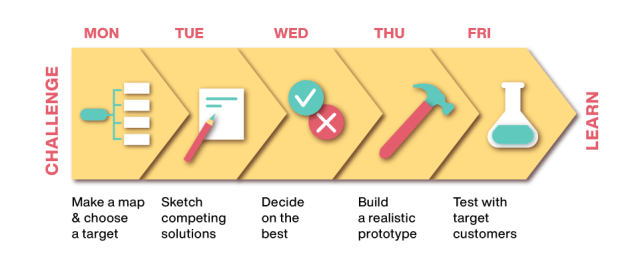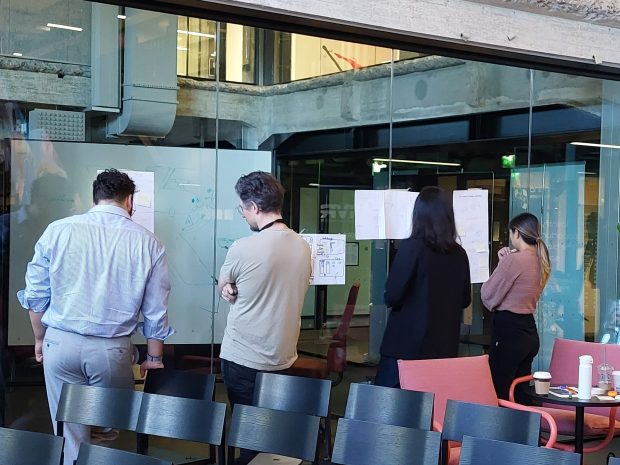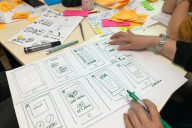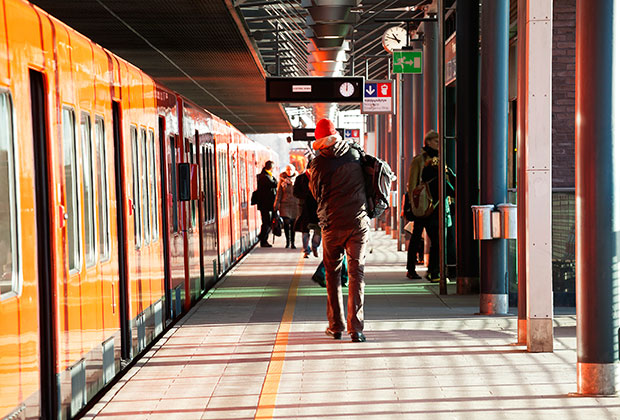It might not sound logical but a Design Sprint actually requires you to slow down at the beginning, or this is how some people perceive it. For some people, they believe they know what they are doing and what the solution is and they just want to jump into the creation part of their idea. But in a group, not everyone will understand the idea the same way from the beginning and not everyone will agree on what solution to create.
There is never one way to solve a problem.
What is a Design Sprint?
The Design Sprint is
- a specific process
- with specific exercises
- done for specific amounts of time
that are tailored to developing a feature of a product, service, or message over the course of 4-5 days. There are 2 main elements: the exercises and the time-boxing.
The order of the exercises is designed to build off each other and to move the process forward at each moment. The time-boxing keeps people on task so that they are not wasting time with chit-chat or off-topic discussions. It helps to focus everyone on a specific exercise if everyone knows that they only have 15 or 20 minutes to produce ideas or concepts that they will present to the group.
These 2 elements are produced within the framework of the Design Sprint process. Image 1 shows the original 5-day Sprint process.

Image 1. Five days Design Sprint chart.
- Monday: Gathering data through interviews with experts (inside and possibly outside of the organisation), mapping the process, and choosing a target
- Tuesday: Sketching solutions to choose from
- Wednesday: Deciding on the best solution (or pieces of solutions)
- Thursday: Building a realistic prototype
- Friday: Testing with target customers
In a later updated 4-day Sprint process, Day 1 and Day 2 have been combined. On Monday, the gathering data is shortened by swapping individual interviews for a group interview and from that data collected, it is mapped and the sketching happens. Day 2 is already where the decisions are made. Everything else is also shifted a day earlier.
Ideation
Ideation takes place in very specific ways and with specific instructions. A lot of the design sprint is considered to be “Together Alone” work. This means that ideas are being produced by individuals quietly without discussion while they are in a group. Others call this “brainwriting”. Like brainstorming but without the noise and the voices of only the bold and the loudest being heard.
Together alone work allows everyone to have time to think, produce ideas (on sticky notes and A4 paper), and to verbalise them in turn. It is only after the time set aside for ideation that there is a discussion. In order for there to be a discussion there needs to be some idea already formed. This rule helps to reduce the amount to time spend off topic.
Including others
One of the main reasons to do “Together Alone” work is to make sure that everyone has a chance to “say” what they think. Many times, in meetings or even other kinds of workshops where brainstorming is prioritised, only the loudest and most out-going participants have the opportunity to speak and be heard.
Until everyone has been heard, and all the ideas have been analysed and discussed, it is undecided what ‘moving forward’ actually means.
Including all voices is very important to get the best outcomes for whatever the Design Sprint is working on. It is this part that sometimes people feel that they are being held back. If they are used to working alone or if they are one of the extroverts of the team, they can be used to going full speed to the next phase of the process.
Frontloading interaction to speed up prototyping
So, from this ‘slow’ start, you are frontloading the team interaction so that it is much clearer to everyone what is happening and what is agreed upon so that in the building phase will go much smoother and faster.
It is faster because
- there are no new ideas being added at the last minute.
- if there are different little teams working on different parts of the solution, they know what they each must do.
- it has been thoroughly discussed and decided collectively.
- everyone has some ownership of the process and the outcome.
This should help in the last two days which are all about building and testing the prototype go much faster as everyone is already on the same page.
Case Study: An adapted Design Sprint for Summer XR Design students
Inspired by the Design Sprint process, the process was adapted for a group of American Master’s students during an intensive Introduction to XR Design. For this process, we had entirely new concepts that the students were working on. While the Design Sprint itself was not entirely suitable for the project, parts of it and, more importantly, the philosophy of the Design Sprint was. The idea that you can take an idea from almost nothing to something that can be presented to people for initial testing.
Each group consisted of 3-5 students. They presented their initial concepts to each other and had to determine which concept, or combination of concepts that they would work on as a group over the 2 weeks.
Many concepts started their lives with one creator. It is important when working on the concept that everyone own the idea rather than the idea is seen as the brainchild of one individual in a team, as this can breed resentment and lack of commitment.
It is really important to “slow down” in the beginning to make sure that the concepts are shaped and changed by everyone in some way. Everyone must feel heard and considered, even if their ideas are not the ones ultimately chosen. This brings sense of ownership that will carry the project through.
Most of the facilitated exercises happened during the first day and a half with the aim to make the concepts team efforts. It was a time for them to slow down (in the sense of not jumping straight to building the prototype) and to really focus on developing the concept with the XR technology they learned during the course and in collaboration with the team.
Concept Design Sprint Schedule
In this modified Design Sprint, we spent the first day exploring the problem and creating a good How Might We Question that we could center our solutions around and got into the concept sketching exercises. This first day was long and hard and everyone was tired. But it was necessary to get fully on track.
The second day was a half day as there was a company visit planned for the afternoon. This day was spent on reviewing the sketches from the day before and to make final decisions as well introduce the need for personas and a journey map. These were required for the final presentation.
During day 3 and day 4 there was no facilitated parts. Essentially, the students were left to work on their concepts while 3 lecturers roamed around answering questions and offering to be a soundboard for ideas and technological possibilities.
The final day was split where the morning was for finalising their presentations/pitches and then the afternoon was the actual presentations by each team.
Team Outcomes
In the end the presentations were comprehensive for the short time that they had to develop their concepts.
The ability for them to slow down at the beginning of the sprint certainly seemed to have allowed them all to feel a piece of ownership of the concept and to move in one direction together. It is a good outcome as the teams were set up in advance by the lecturer without any prior knowledge of the participants.
The slowing down also helped with elements of team building. When a group slows down at the beginning of the process, there is an opportunity for people to come together and hear each other. It also gives them time to think about how they can combine ideas and make sure that they are solving the same problem. With the cohesion and clarity that results from taking time at the beginning of the process, the group is able to jump more confidently into the prototyping phase and move more quickly from that point onwards.
Author
Pamela Spokes works as a Service Designer in Metropolia’s RDI team. Originally from Canada, Pamela has years of experience in university admin focusing on international recruitment, marketing, and the international student/staff experience. With a Bachelor’s from Canada, a Master’s degree from Sweden, an MBA in Service Innovation & Design from Laurea, and her AmO from Haaga-Helia, she is interested in purposefully designed experiences that are centred around the user. Don’t be surprised if she knocks on your door to talk about learning co-creation methods through intensive learning experiences.









Ei kommentteja